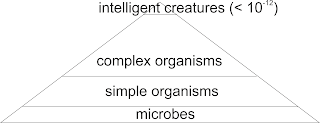Alien life spread
Currently we have thousands of proved exoplanets and it looks like most of stars have planets, even neutron stars do. But proved exoplanets generally are inside 1000 light years distance from the solar system. Can we suppose that other parts of our galaxy are the same? According to current knowledges it looks rather doubtful especially about the center of the galaxy.
It looks extremely important that the region wouldn't exposed to strong gravitational waves to make planets to be able to form and espcially to be habitable. In a galaxy center can exist a lot of black holes that will cause gravitational storms and even if it won't hinder planets to be formed such planets will have seisms constantly and huge amount of volcanos. Also black holes and neutron stars may cause powerful X-rays that may blow off planets atmospheres.
But not only a galaxy center may have powerful enough gravitational waves to cause such cataclysms. Solar system doesn't move across the spiral galaxy sleeves but a very small radial distance range can keep such conditions. Planets around stars that cross galaxy sleeves may stay habitable only very short periods.
As well as a small part of our galaxy stars can have long period habitable planets, low part of galaxies may have suitable for habitable planets regions. Quasars looks like to have gravitational storms and powerful X-rays across all the galaxy. Too small galaxy may be exposed to gravitational storms caused by bigger galaxies of a cluster. Also they may have lack of heavy elements for rocky planets. So rather small part of universe planets may stay habitable for some long period.
A lot of other factors may affect how long some planet may stay habitable and if it can have complex organisms. Outer orbits of gas giants in the solar system looks to protect the Earth against meteorites. But the gas giants caused to appear the asteroids belt so as well as the Earth have enough distance from it, Mars is exposed to meteorites from asteroids belt. Now we do not have representative data about typical gas giants location 'cause hot gas giants are easier to be discovered using contemporant technologies.
The moon also looks to help much to the Earth to stay habitable for a very long period. It's rather uncommon that not very big rocky planet have so big moon. One of the moon role to keep the Earth habitable can be supposed that it keeps volcanic activity stable for a long time. The moon gravitation may provoke small volcanic eruptions that prevents the magmatic pressure growth. The same time Venus without a moon could get huge volcanic activity after magmatic pressure growth and became unhabitable as we know it. But Mars without volcanic eruptions got it atmosphere too thin to keep complex forms of life.
To estimate another part of the Drake equation, i. e. what time may be required for a potentially habitable planet to get some forms of life we can suppose that abiogenesis and panspermia can be complementary factors. Real facts can be discovered later e. g. after some more Enceladus exploration but now we can suppose that panspermia has some distance limit. Also such distance may depend if some region of a galaxy has black holes or neutron stars and many other factors. But if some region of galaxy has too few near located habitable planets for panspermia we can suppose that abiogenesis may require much more time that can be even more than some planet will stay potentially habitable.
Another factor can be a quantity of some required elements. Surely we have to consider if some alternative life forms can exists in a different temperature range. But e. g. just dense enough atmosphere and liquid natural gas on Titan do not help to appear some complex life forms 'cause otherwise they would be already discovered by Huygens probe. Also we can suppose that on some planets lack of sulfur, phosphorus or nitrogen may impede complex life forms to appear. If some planets do not have some of these elements on their surfaces it can limit potential life complexity. Also ocean planets that look to be very widespread according to currently known facts may to be unsuitable for intelligent creatures to appear.
So the following diagram can illustrate alien life spread. The pyramid top value is random and is just aimed to show that even entire galaxy may do not have at least one planets with intelligent creatures. It's just related to a roughly estimated quantity of planets in our galaxy.
Also as it was already mentioned in Drake equation we have to make difference between just intelligent creatures and techonologically advanced civilizations. At first we can see that known history is much shorter than human existence period. At second we know about Ancient Egypt or Maya pyramids that have their spiritual but not technological purposes. They took very much resources of such technologically undeveloped civilizations. Just quantity can show that such situation at least for our planet is much more common than technological way of a civinlization development.
We can be sure that our planet didn't have technologically advanced civilizations earlier. Many contemporary materials are much less exposed to degradation than natural ones. If dinosaurs skeletons can be find yet technological artefacts couldn't disappear earlier.
The question why humans began to develop technologies in Western Europe in the previous millennium is rather complicated. We need to consider climate and tides specialities, other states communication and many other factors. Surely tides can be rather different on other habitable planets, the continents location may also have various specialities. But global cataclysms may occurs every some million years on any planet and intelligent creatures may disappear before they create a techonologically advanced civilization. After that a planet may not stay to be habitable enough time to make intelligent creatures to reappear.

Comments
Post a Comment